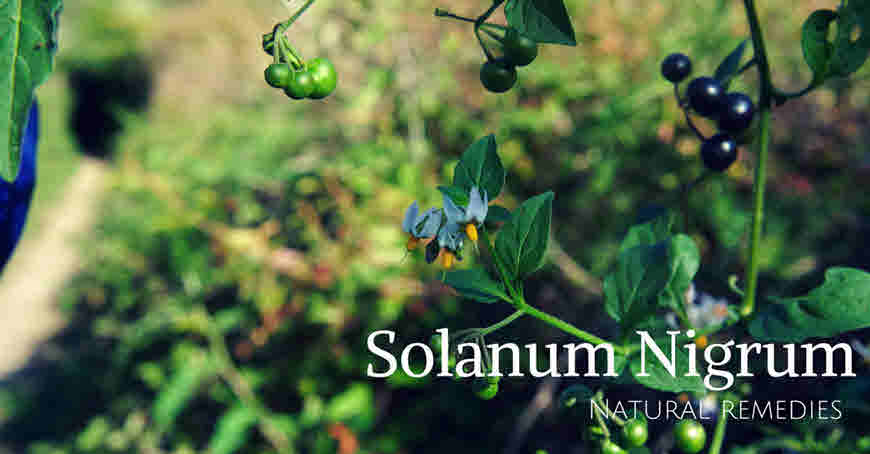The common name of Solanum nigrum is black nightshade or Makoy (Hindi). It belongs to family Solanaceae. This plant grows as weed in waste lands all across India. In traditional medicine system, Makoi is used for the treatment of many ailments such as inflammation, pain, the liver diseases, fever, etc.

The plant leaves are cooked like vegetable and eaten. The fresh leaves juice is taken orally in the form of fresh juice or decoction for treating disease. The whole plant is used for medicinal purpose. In many parts of country, the roots are boiled and given to women to boost fertility. The root juice is used as medicine for asthma and whooping cough.
Scientific classification
Kingdom: Plantae Order: Solanales Family: Solanales Genus: Solanum Species:nigrum
Latin name: Solanum nigrum Linn. Synonym: S. rubrum Mill.
There are two varieties of the plant, one bears black fruit other red fruits. The black berry fruits are considered toxic.
Active Constituents
Major active components are glycoalkaloids, glycoproteins, and polysaccharides. It also contains polyphenolic compounds such as gallic acid, catechin, protocatechuic acid, caffeic acid, epicatechin, rutin, and naringenin.
Vernacular names
Sanskrit name: Kakamachi Bengali: Gudakamai English: Common nightshade, Garden Night Shade Gujrati: Piludi Hindi: Makoya Kannada: Ganikayeagida, Ganikegida, ganike, Ganikesopu, Kage hanninagids Malayalam: Karinthakkali, Manatakkali, Manjathakkali Marathi: Kamoni Oriya: Lunlunia, Lunilunika Punjabi: Mako Tamil: Manarthakkali, Manaththakkali, Manitakkali, Maniththakkali Telugu: Kamanchi Urdu: Makoh, mako
Plant Distribution
Herbaceous annual weed, 30-45 cm high, found throughout India in dry parts;quite common in cultivated lands, roadsides and gardens. S. nigrum is also distributed in temperate Asia, Japan, Europe and Africa.
Medicinal uses of Solanum nigrum or Makoi
Solanum nigrum is used for the treatment of diseases for hundreds of years. It has expectorant, analgesic, sedative, diaphoretic properties. It is external application cures skin diseases and gives relief in burns, itching, pain, etc. As per Ayurveda, this plant is hot is potency and balances tridosha.
Also Read : Some important formulations that contain the dried plant of Solanum nigrum are Maha vishgarbha Tail, Rasaraja Rasa.
Here is listed some of the common medicinal uses of Kakamachi or Makoi (S. nigrum).
Arthritis, joint pain, rheumatism
Poultice of leaves is prepared and applied externally on the painful joints.
Insomnia or sleeplessness
For insomnia roots of the plant are used. The roots are boiled in water and a decoction is prepared which is filtered and taken 10-20 ml.
Pain in ears
The lukewarm juice of leaves is used as ear drop to get relief from pain in ears.
Stomatitis
Stomatitis is inflammation of the mucous membrane of the mouth. This disease is known as Mukh-Pak in Hindi. For this ailment, chewing 5-6 leaves of the plant are helpful.
Enlargement of the liver
In this condition, juice of the plant are given. Fresh juice is extracted and heated in earthen vessel till it changes color. This is given in a dose of 25-50 ml for a few days.
Spleen enlargement
In spleen enlargement, the decoction of the plant are prepared. In this decoction sendha namak and cumin seeds are added and taken.
Skin diseases, ring worms, rabies
A paste of leaves is prepared and applied externally.
Stomach-ache, stomach ulcer, cough
The fresh leaves are cooked like vegetable by adding onion and jeera and eaten. The fresh leaves juice is also taken for curing the same.
Side-effects
Makoi or S. nigrum contains glycoalkaloid solanine. Solanine has varying degrees of toxicity in a dose dependent manner. The toxicity of the plant depends on the climate, soil type, season, and maturity. The green unripe berries are generally considered more toxic than the ripe berries. Few cases of poisoning after eating berries of the plant are also reported. By cooking, boiling (decoction) the toxic components are destroyed as the plant are reported to be edible after cooking.
are riped red berries useful for body? are these red berries poisionous?
Is this plant useful in kidney disease/protienurea/lowering of creatinine.
Is this plant useful in proteinuria?
What is the Telugu name of makoi…
Kamanchi mokka